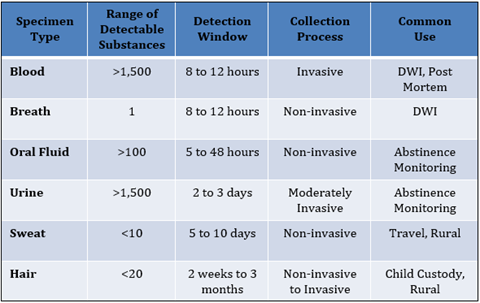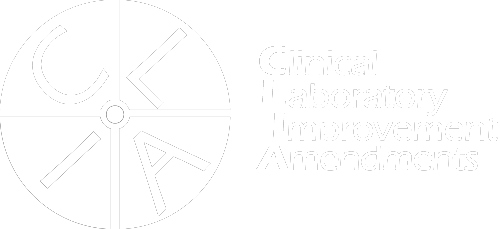Richmond, Va. – The optimal specimens for drug testing is dependent on a variety of factors. In order to properly test for substance use, it is important and helpful to know the different facets of each specimen you have the ability to test.
Generally, choosing the optimal specimens for drug testing is determined by the type of drug use you are interested in. However, other items are essential to consider depending on your objective. This includes the detection window, range of detectable substances, test frequency, the collection process, and substance combinations. Some specimens allow you to determine if a person is currently intoxicated, some specimens are best to test for while monitoring abstinence, while others determine history of use. The six primary specimen options are (1) blood, (2) breath, (3) hair, (4) oral fluid, (5) sweat and (6) urine. While there are others, these six provide good information and are useful for substance use monitoring. The ability to identify new substance use to improve outcomes is heavily reliant on choosing the optimal specimen type to test for your specific objective.
Understanding how detection windows vary and factor into the specimen type is crucial. The amount of substance consumed, absorption into the blood stream, distribution to organs and tissues, metabolism to inactive compounds, and elimination from the body are all functions of detection window. While blood, breath and oral fluid can often detect new substance use within minutes of consumption, sweat may require multiple days of use, and hair can take up to two weeks before substance use is detectable. For example:
- In seconds to minutes, smoked substances appear in blood
- In a few minutes to two hours, orally ingested substances appear in blood, then oral fluid, then breath
- In about one hour, substances start to appear in urine; and
- In one to seven days, substances appear in hair
The length of use history a specimen can carry is also important to note. Hair can detect substance use from several months ago, while blood and breath can only detect substance use for about 12 hours. For example, substances tend to be cleared from blood or oral fluid within two days; after three days, most substances are cleared from urine; and between one week and several months after use, substances are only detectable via hair.
In addition, it is important to note that detection windows vary not only between specimen types but also by method of collection.
|
Drug Type | Oral Fluid Detection Window | Urine Detection Window |
|
Amphetamines (Amphetamine, Ecstasy, Methamphetamine) |
2 days |
3 days |
|
Buprenorphine |
2 days |
3 days |
|
Benzodiazepines |
3 days |
1-7 days |
|
Cannabinoids (THC) |
1-2 days |
3-5 days |
|
Cocaine |
<1 day |
<1 day |
|
Opiates (Morphine, Heroin, Hydrocodone, Hydromorphone, Oxycodone) |
1-2 days |
1-3 days |
|
Fentanyl |
1 day |
2 days |
|
Tramadol |
1 day |
1 day |
The following specimen type briefs serve as a general guide to selecting the optimal specimen for a given situation. The briefs are applicable to most situations, but are not completely comprehensive. When in doubt, ask your laboratory for advice.
Blood is used to determine if the donor is currently intoxicated, telling us what the central nervous system is currently exposed to, while indicating possible or probable impairment. Blood is most commonly used for operating machinery (e.g. cars) while intoxicated (OWI, DUI, DWI) and post-mortem situations, as it is a more invasive specimen option compared to breath.
Advantages: Very difficult to adulterate and has an extensive range (>1,500) of detectable substances.
Disadvantages: Short detection window (8-12 hours), an invasive collection process, requires phlebotomist or hospital to collect, noisy specimen type, low concentration of drug levels, and cost.
Breath is used to determine if the donor is currently under the influence of alcohol. Breath alcohol results are similar to blood, oral fluid and urine alcohol results.
Advantages: Difficult to adulterate, immediate results, and readily available in nearly unlimited quantities for most donors.
Disadvantages: Limited to alcohol testing, short detection window, certification required to calibrate devices, and the test is best conducted by a certified breath alcohol technician.
Oral Fluid is commonly used to detect recent use (i.e., 1-2 days ago), although blood and oral fluid are strongly correlated for some substances (e.g., alcohol, marijuana) allowing for the detection of current intoxication.
Advantages: Difficult to adulterate, less invasive collection process, and does not require a gender-specific technician to conduct collection.
Disadvantages: Short detection window (5-48 hours), low concentration of drug levels, a small sample volume which can limit follow-up or broader testing, and higher cost.
Urine is ideally used for abstinence monitoring.
Advantages: High concentration of drug levels, detects recent and past usage (2-3 day detection window), provides extensive range (>1,500) of detectable substances, small sample volume supports multiple tests, and low cost
Disadvantages: Ease of adulteration, possibility of a shy bladder, and evidence-based collection process required.
Sweat is used for short- to intermediate-term monitoring (e.g., client is traveling and unable to provide urine or oral fluid sample).
Advantages: Non-invasive specimen collection and eliminates need to handle a “yucky” sample.
Disadvantages: Incidental environmental exposure, very low concentration of drug levels requires accumulation of use (i.e. 2-3 beers for transdermal bracelets), a narrow range (<10) of detectable substances, an extended lead-time needed to identify use, removal caused by life activities or tampering, and cost.
Hair is used to monitor use over extended periods of time or to establish a baseline of use history.
Advantages: Extended detection window (2 weeks to >3 months), difficult to adulterate, and non-invasive.
Disadvantages: Narrow range (<20) of detectable substances, requires accumulation of use delaying relapse identification, and results can be skewed by some hair colors, textures, and treatments.

For additional questions about optimal specimen type for alcohol or drug use testing, contact Averhealth and we will be happy to advise you on the best method of testing that matches your objective.


